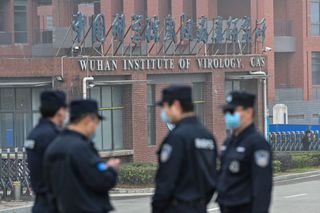Prominent scientists call for more investigation into origins of coronavirus
The authors argue that current evidence is not strong enough to determine if the virus originated from nature or from a lab leak.

More than a dozen researchers have published a letter in a top scientific journal calling for further investigations into the origins of SARS-CoV-2, the virus that causes COVID-19.
In the letter, published Thursday (May 13) in the journal Science, the authors say that two theories — that the virus was accidentally released from a lab or that it spilled over naturally from animals — "both remain viable."
"Knowing how COVID-19 emerged is critical for informing global strategies to mitigate the risk of future outbreaks," they wrote.
Related: 14 coronavirus myths busted by science
The authors, who include 18 prominent scientists, are not the first in the scientific community to call for more investigation into the new coronavirus's origins. But many previous statements on the issue have clearly favored one theory over the other, while the authors of the new letter tried to remain neutral, arguing that current evidence is not strong enough to favor either theory, according to The New York Times.
"Most of the discussion you hear about SARS-CoV-2 origins at this point is coming from, I think, the relatively small number of people who feel very certain about their views," Jesse Bloom, lead author of the letter and associate professor at the Fred Hutchinson Cancer Research Center in Seattle, who studies virus evolution, told the Times. "Anybody who's making statements with a high level of certainty about this is just outstripping what's possible to do with the available evidence."
Other authors of the letter include Dr. David Relman, a professor of microbiology and immunology at Stanford University; Ralph Baric, a professor of epidemiology and microbiology at the University of North Carolina who has spent decades studying coronaviruses; and Marc Lipsitch, a professor of epidemiology and director of the Center for Communicable Disease Dynamics at Harvard T.H. Chan School of Public Health, who uses mathematical modeling to study infectious disease transmission.
Sign up for the Live Science daily newsletter now
Get the world’s most fascinating discoveries delivered straight to your inbox.
The origins of SARS-CoV-2 have been hotly debated since the pandemic began, and some experts have said we may never know exactly where the virus came from, Live Science previously reported.
In March 2021, the World Health Organization (WHO) released the results of a months-long investigation into the origins of SARS-CoV-2, conducted in partnership with Chinese scientists. The report concluded that a spillover from wildlife through an intermediate host was the "likely to very likely pathway" for the original transmission into humans, while introduction through a lab accident was "extremely unlikely."
However, many countries soon criticized the report for a lack of transparency and incomplete data, according to CNN. The U.S. and 13 other governments have since released a statement expressing concern about the WHO findings.
The new letter notes that in the WHO report, "the two theories were not given balanced consideration" and that "there were no findings in clear support of either a natural spillover or a lab accident."
"A proper investigation should be transparent, objective, data-driven, inclusive of broad expertise, subject to independent oversight and responsibly managed to minimize the impact of conflicts of interest," the authors of the Science letter said.
Some experts not involved with the letter said they support the need for further investigation on the virus's origins, but they disagreed that the two hypotheses currently have equal evidence supporting them.
"There is more evidence (both genomic and historical precedent) that this was the result of zoonotic emergence rather than a laboratory accident," Angela Rasmussen, a virologist at University of Saskatchewan's Vaccine and Infectious Disease Organization in Canada, told the Times.
Originally published on Live Science.

Rachael is a Live Science contributor, and was a former channel editor and senior writer for Live Science between 2010 and 2022. She has a master's degree in journalism from New York University's Science, Health and Environmental Reporting Program. She also holds a B.S. in molecular biology and an M.S. in biology from the University of California, San Diego. Her work has appeared in Scienceline, The Washington Post and Scientific American.
Most Popular

